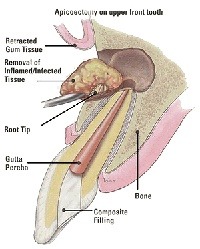Every tooth is made of two sections and three layers. The top section, visible when you smile is the crown, and the portion of the tooth below the gums is known as the root.
The layers of the tooth are the protective hard enamel, supportive dentin, and the interior soft pulp where the nerve structure of the tooth is housed. Treatment of the interior layers of teeth and the root systems is traditionally covered by the dental specialty called endodontics.
An apicoectomy, sometimes referred to as a root end surgery, is necessary following endodontic treatment (a root canal) that is unsuccessful. In most cases of root canal failure, the issue occurs because of an issue at the very end of the tooth root known as the apex.
Through this tip of the root, nerves travel out and connect to the rest of the body. The front teeth typically have a single root, but molars can have two or more supportive roots that anchor them to the gum and jawbone.
Within the roots, there is one main canal where the nerve and pulp are housed, but there are also a number of smaller connected branches. Even if a root canal removes the majority of infected tissue, a small amount of trapped bacteria or inflammation in one of these branches may lead to reinfection or infection of the surrounding gum tissue and alveolar bone. When this happens, root end surgery is required.
The procedure itself is fairly straightforward. First, gum tissue is carefully pulled back from the affected tooth. Any infected gum and bone tissue is removed.
Then the apex of the root (pointed end) is removed in order to ensure the infection does not recur. The removed root structure is restored with a small filling.
Finally, the gums are carefully stitched back in place to protect the surgical site.


 Website Powered by Sesame 24-7™
Website Powered by Sesame 24-7™